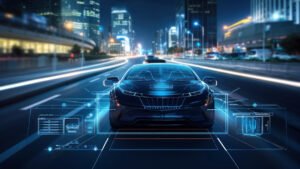Electric vehicle (EV) technology is rapidly transforming the auto industry by providing an alternative to gasoline-powered vehicles. Electric cars use an electric motor to propel the vehicle, running on electricity stored in batteries. The move to electric vehicles is a response to environmental concerns and the need for greener ways to get around. As technology advances, electric vehicles are becoming more accessible, cheaper, and better at harnessing energy. This is leading to dramatic changes in the way people travel and the way the auto industry operates.
1. The Rise of Electric Cars and Trucks
The idea behind electric vehicles is not new. The first electric cars were built in the 1800s. But they were quickly replaced by gasoline-powered cars because they were more convenient and had a longer range. Concerns about climate change, air pollution, and limited fossil fuel supplies have fueled renewed interest in electric vehicles in recent decades. With the help of government programs and improvements in battery technology, electric vehicles (EVs) are poised to replace internal combustion engine vehicles (ICEs) as the primary way people get around.
2. How Electric Cars and Trucks Work
Electric cars are powered by an electric motor that draws power from a battery pack. Electric vehicles don’t use gasoline or oil to power an internal combustion engine like regular cars. Instead, they use electricity, which can be generated from renewable energy sources like solar and wind. Electric vehicles rely on batteries for their power. New battery technology, especially lithium-ion batteries, increases the amount of energy they can hold, allowing them to last longer and charge faster.
3. Different Types of Electric Vehicles
There are many types of electric vehicles on the market today, each with a different amount of power. The Tesla Model 3 and other battery electric vehicles (BEVs) run solely on electricity and must be charged at a charging station or outlet. A plug-in hybrid electric vehicle (PHEV), such as the Chevrolet Volt, has both an electric motor powered by a battery and a gasoline engine. This allows them to switch between electric and gas. Hybrid electric vehicles (HEVs), such as the Toyota Prius, have both an electric motor and a gasoline engine. The battery is not installed but is charged when the car brakes.
4. Advantages of Electric Vehicles
Electric cars are better than regular gasoline cars in many ways. Environmental safety is one of the best things about them. Electric vehicles (EVs) do not emit smog or greenhouse gases into the air, which helps combat climate change. In addition, because electric motors use more energy from the battery to move, they use less energy than cars with an internal combustion engine (ICE). Because electric vehicles do not require oil changes or as many moving parts, they have lower operating and maintenance costs. They also use less fuel.
5. How Electric Cars Impact the Environment
A key part of reducing the auto industry’s carbon footprint is electric vehicles. Electric vehicles can help slow climate change by shifting people away from gasoline and diesel cars, especially those that run on clean energy. While the process of making electric vehicles (especially batteries) is environmentally unfriendly, the total lifecycle emissions of electric vehicles are much lower than those of regular cars. As recycling technology advances and more people use renewable energy, electric vehicles will provide even more benefits to the planet.
6. The Role of Batteries in Electric Vehicles
Battery science is a key part of how electric vehicles work. The electric vehicle market has grown tremendously thanks to the advent of powerful, long-lasting batteries. Lithium-ion batteries are currently the most widely used type in electric vehicles, offering a good balance of cost, weight, and energy density. However, scientists are working on new battery technologies, such as solid-state batteries, that can deliver more energy per unit volume, faster charging times, and longer battery life. As battery technology improves, electric vehicles will become more fuel-efficient and cheaper.
7. Electric Vehicle Charging Infrastructure
The lack of charging stations is one of the major issues that prevent people from buying an electric car. Regular cars can fill up at thousands of gas stations, but EV drivers need access to a reliable network of charging stations. To solve this problem, both the government and private companies have invested heavily in building charging stations in cities, highways, and even remote areas. There are three levels of charging: Level 1 is slow charging via a regular wall socket, Level 2 is fast charging at a charging point, and Level 3 is DC fast charging that can charge an EV battery in minutes.
8. Challenges Facing Electric Vehicles
Although electric vehicle technology has come a long way, there are still some issues that need to be solved before they can be widely used. Many people are concerned about the short driving range of electric vehicles, especially cheap electric vehicles. Although charging times are getting faster, they are still longer than it takes to fill a tank. The high initial price of electric vehicles will also deter some people from buying them. Battery production has environmental implications, and rare materials like lithium and cobalt are hard to come by, raising sustainability concerns.
Conclusion
Electric vehicle technology is driving massive changes in the automotive industry. Electric vehicles (EVs) are the future of transportation because they can reduce carbon emissions, and operating costs, and change the way cars are built and driven. While challenges remain, better battery technology, government support, and increased consumer interest are driving the development of electric vehicles. As the automotive industry changes, electric vehicles will become increasingly important in making transportation more environmentally friendly and efficient.
FAQs
1. What is an Electric Vehicle (EV)?
When a car does not have a standard internal combustion engine (ICE), it runs on electricity stored in the battery and electric motor. This is called an electric vehicle (EV). Electric vehicles (EVs) run on electricity, which can come from the grid or clean energy sources like solar and wind.
2. What are the functions of electric vehicles?
The electric motor is powered by a rechargeable battery. The energy is stored in the battery and sent to the engine, which turns the wheel. When the battery is empty, it must be plugged into a power outlet or charging point to recharge.
3. What are the benefits of electric driving?
Electric vehicles have many advantages, such as lower fuel costs, less maintenance, no tailpipe emissions, quieter operation, and reduced greenhouse gas emissions when using renewable energy sources, which have a good impact on the environment.
4. How far can an electric car drive on a single battery charge?
Electric vehicles have different ranges, depending on the model. Today, electric vehicles can travel 240 to 350 kilometers on a single battery charge. Some of the best cars, such as the Tesla Model S, can travel more than 650 kilometers. The range is also affected by driving style, weather conditions, and battery size.
5. How long does it take to charge an electric car?
The time it takes to charge depends on the charging point and the size of the vehicle’s battery. A standard wall outlet (level 1) can take 8-20 hours to fully charge. Level 2 chargers (such as those in homes or public spaces) typically take 4-8 hours. Level 3 (DC fast charger) takes 30-60 minutes to fully charge an EV.




Comments
Thank you for your articles. I find them very helpful. Could you help me with something?
Thanks for posting. I really enjoyed reading it, especially because it addressed my problem. It helped me a lot and I hope it will help others too.
You helped me a lot by posting this article and I love what I’m learning.